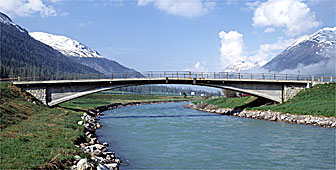Maillart: A revolutionary bridge-builder

A "revolutionary" bridge in Switzerland, located in the southeast of the country, is this year celebrating its 100th birthday.
Robert Maillart, a young Swiss engineer, built the bridge over the Inn River in the Graubünden village of Zuoz in 1901. That slender arch of reinforced concrete was the first of Maillart’s “revolutionary bridges”.
The description “revolutionary” comes from Princeton University’s David Billington, who writes that Maillart’s extraordinary skill was to build structures that were beautiful, simple and cheap. Today several of his bridges are considered among the greatest of the 20th century.
In his own day, however, he was viewed with scepticism. His designs were distrusted by fellow engineers and disliked by public officials, who were more comfortable with heavy, monumental-looking structures.
In his book on Maillart, the Swiss artist, Max Bill, describes how often the engineer’s proposals for bridges were either turned down by juries or else radically altered with unnecessary additions. Maillart’s bids were also so low that officials were afraid to hire him, fearing that such cheap bridges could not possibly be safe.
As a result, most of his bridges were built in out-of-the-way places, where town councillors didn’t care what they looked like as long as they were affordable.
The Salginatobel Bridge, for example, which was declared an international historic monument in 1991, spans an 80-metre ravine near the village of Schiers in Graubünden. The Rossgraben and Schwandbach Bridges, also considered especially beautiful, are near Schwarzenburg in Bern.
Maillart, born in 1872, attended Zürich’s Federal Institute of Technology and in 1902 opened an engineering office. In 1912 he and his family moved to Russia to continue his career there, but he was caught in the Russian Revolution and almost killed.
Returning to Switzerland without any money, he nevertheless opened a new office in Geneva in 1919 and eventually expanded to Bern and Zürich. He continued to build innovative bridges, and some buildings, until his death in 1940.
Maillart’s former office on Bern’s Kollerweg has remained in the hands of construction engineers. Taken over by one of his co-workers after Maillart’s death, the rooms are now home to Diggelmann and Partner, a firm that recently built a bridge near Leukerbad.
“The fact that most of Maillart’s bridges were built in the countryside has saved them,” says Martin Diggelmann. “They have lasted twice as long as other concrete bridges their age, partly because of their excellent design but also because they are in such obscure places that they haven’t had to bear heavy traffic.”
“These bridges were built to carry seven tonne loads,” explains Diggelmann, “but they have had to bear four times that weight. They’ve held up extraordinarily well, but now they must be renovated.”
Diggelmann has been hired by canton Bern to fix Maillart’s Traubach and Bohlbach bridges near Habkern. His difficult job will be to strengthen them without altering their appearance.
Seven years after Maillart’s death, the Museum of Modern Art in New York held an exhibition devoted to his work. Since then, many books and articles have been written about him, but he is still generally unknown in Switzerland.
The bridge in Zuoz is the first to use Maillart’s “hollow-box arch”, which redistributed the weight of the roadway deck so that the arch could be one-third as thin as in a conventional bridge. For the people of Zuoz, however, it’s just a way to cross the river, and no celebration of its 100th birthday is planned.
According to Diggelmann, Maillart’s fame is greatest among engineers. “He fascinates us,” says Diggelmann, “because he managed to design beautiful forms that worked very well and cost very little. His work is proof that the solution to a construction problem can be both efficient and elegant.”
by Kim Hays
A map showing the locations of Maillart’s bridges can be ordered from the research office of the Swiss cement industry: tel. 062 887 7253; fax 062 887 7270; e-mail bibliothek@tfb.ch.

In compliance with the JTI standards
More: SWI swissinfo.ch certified by the Journalism Trust Initiative








You can find an overview of ongoing debates with our journalists here . Please join us!
If you want to start a conversation about a topic raised in this article or want to report factual errors, email us at english@swissinfo.ch.